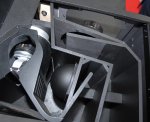Hi Peter
The SBH-10 is an astigmatic point source horn and if one were to cut it into 4 parts, it could still work IF the ends of each segment were “close enough” to sum into one source all the way up high.
Given at 20Khz the WL is about 5/8 of an inch, if one had a spacing of say 5/16 inch between the ends of each segment, one could get good summation up to about 10KHz. In other words, if there were two layers of plywood (a top and bottom for each segment), this is already much too large to operate up high and still be acting as if it were one source located about 25 feet behind the cabinet.
Also, the individual segments would not have the nominal 2.5 degree dispersion angle that the 10 degrees / 4 segments would suggest and changing the angle between them or changing the length puts one into the pattern flip mode. In other words, if one made a horn which was 10 degrees vertical and 90 degrees horizontal, the height of the horn mouth must be 9 times the width of the horn mouth or one has the diffraction / pattern flip problem.
Call it “flexibility” or other term, there is only one acoustically correct geometry given the V and H angles and source width and height, this is why line arrays spray more and more energy to the sides outside the desired pattern when one makes them longer or more curved, as a radiating aperture, the same rule applies to a tight packed row of direct radiating sources as well but unlike a horn’s pattern control, these also radiate a lot more energy up and down as well..
Of more importance is constant directivity as the spectral balance doesn't change appreciably as one moves off axis, only the spl falls. This is how one can have it "sound the same everywhere" in a stadium and still have the spl variation within 2 dB or less in every seat. One uses the constant beam width to advantage by having the right mounting height and angle.
Here is a single J-3 where you can hear that part, the first video was up close where th eguy walked around and except for when he was close to the subwoofer, it sounds th esame under it as it does out in front. The second one is far away from it and still sounds very similar.
https://www.youtube.com/watch?v=5MOG_sPejGA
https://www.youtube.com/watch?v=RiS0-lqSUX4
If one had the ceiling problem you mentioned, one could use the lower half if mounted against the boundary and then the h/w ratio is preserved via the acoustic mirror image.
Further, since most loudspeakers are multi-way systems, it isn’t just the hf source that is a concern, the mid and lf sources also produce an interference pattern when they are too far apart with the upper and lower ranges or if there is more than one source. These need to be within ¼ wl at the highest F of concern as well and in the sbh10, the lf emerges from the same paraline lens as the hf does. This is the same for all the Synergy horns (part of the patent), where the upper and lower ranges combine, they are less than ¼ wl apart, where multiple drivers interact which the horn, they are less than ¼ wl apart. For example, at 1KHz, this means the sources can be no farther than about 3 ¼ inches apart.
This is seen clearly when you do an ETC of a paraline or other synergy horns, there is only one short arrival, as if it were a single driver in a very deep horn.
What did you think of the sound in the video’s?
Even though taken with a cheap camcorder or Iphone, I think one can hear they are very different from line arrays, especially the 3 box demo where Mike walks the field at Penn state.





